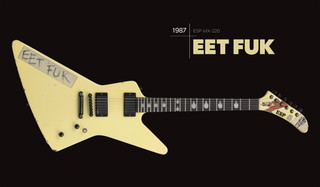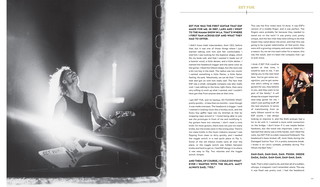Messengers: The Guitars of James Hetfield
Messengers: The Guitars of James Hetfield

Click on the preview images below to see each page in high-resolution.
For about 35 years, we’ve had the privilege at ESP to work with one of the most influential and beloved guitarists in the world of heavy music: James Hetfield of Metallica. His new book Messengers is an incredibly detailed trove of beautiful photos and entertaining, informative stories focused on his personal collection of guitars. Every single instrument in Messengers has a story, and for any fan of Metallica or of guitars in general, this 400-page tome is perhaps the most comprehensive and accurate collection of any musician’s instruments ever produced.
We were lucky enough to preview the entire book, which is now available for pre-order and comes out in November. James and the team spent more than two years painstakingly immersed in the world of his guitars, researching every detail and putting together this outstanding book that offers a completely unique perspective you won’t find anywhere else. We had a conversation with Gabriel Kuo, the editor and art director, who walked us through the making of this project.
Please give us a basic description of what people should expect in the Messengers book by James Hetfield of Metallica.
The guitars that are showcased in Messengers were all hand-picked by James, and each one represents a vital chapter in his musical journey. Some are his trusty favorites, while others have a notable importance and history, and then there are a few that are especially unique in how and why they were crafted or acquired. Each guitar is introduced with a reflective and intimate essay from James, giving the reader great insight into the significance of these guitars. Even fans that know the provenance of some of these guitars will be given a deep dive from James that reveals the emotional context of his attachment to these pieces, some of which is quite confessional. And for the true guitar geeks and Metallica historians, it covers all the battle scars from endless touring, the DIY modifications, and countless customizations. And, it really is so incredibly satisfying to see all these guitars in a single cataloged document.
How long did the development of this book take, start to finish? There’s an amazing amount of detail and it seems like a massive project.
The project started in early 2020. At that time, James was already in the process of having his guitars photographed in the studio, which not only gave us a tremendous head start, but supplied us with a dizzying amount of beautiful and crisp studio shot imagery. It was through this initial photo editing stage that we started to really understand the utility of these guitars for James. Dents, belt buckle gashes, peeled-off sticker residue, ink scrawls, stripped backsides, broken neck seams—stuff you cannot see in a magazine or online. These guitars, especially the early ones, were a roadmap of James’s attitude, power, intensity, and at times, boredom. We decided to showcase these imperfections, giving focus to the damage and their underlying stories. James then spent some time providing us the personal history, his memories, and the storytelling of each guitar. Our next task was to track down the luthiers, artists, technicians, and roadies who could bring their expertise and narrative to the project. Interviewing everyone took time, and sometimes we would need to cross reference with different sources just to ensure we had factual accuracy, particularly since some of these details are from the 1980s and ’90s. It was only after gathering this content that we could then start visualizing how all the elements would coalesce into book form. Once we got layouts going, not only was James great in guiding us as to what he felt was important and what was not, but he empowered us with an enormous amount of trust. In the end, it took us about two and a half years to complete—almost as long as the Black album tour!
 Were you already pretty familiar with most of the ESP Guitars that were highlighted in the book, or was this a big learning experience for you?
Were you already pretty familiar with most of the ESP Guitars that were highlighted in the book, or was this a big learning experience for you?
I grew up learning guitar in the ’80s, so it was the golden era of sharp, pointy, excessive and overly designed metal guitars—B.C. Rich Warlock shapes, Ibanez JEM 7-strings, wild Jackson paint jobs. ESP was really emerging at that time, and their offerings were, in contrast, very tasteful, sleek, and pro-level. At the time, my favorite players were all using ESP—Hetfield, Hammett, George Lynch, Vernon Reid, Page Hamilton. These are proficient, heavily technical players, and so ESP filled a niche for artists that relied heavily on utility, precision, and performance. The classic MX guitars that James had during the early days were certainly very familiar to me. And I had seen variations of the current Signature Snakebyte. But some of the others, like The Grynch and the Trucksters, were new discoveries for sure. I believe James owns about 400 guitars, and for him to include so many ESPs in a book that showcases only 45 guitars from his collection is a testament to his lifelong relationship with Matt and the team at ESP. Evolving alongside an artist like James takes creativity, nimbleness, and execution. The book unfolds the evolution of young James to Papa Het and his guitars in tandem with that growth. It’s rewarding to see the design of all the ESP guitars progress together with James over the decades.
What was it like working with James and the team at Metallica HQ to help put together this epic trove of information?
Ray Masterson, who works with James on most everything, gave us the structure and access we needed to build this book into a fire-breathing beast. From start to finish, Ray provided us with the proper framework, which really helped us maximize our resources. I spent countless hours talking and texting with Zach Harmon, who has been Metallica’s tech and gear manager since the ’80s and knows every guitar, amp, and cord at HQ. Zach was so generous with his time and knowledge, and it was a blast to talk about amp dialing and classic ESP guitars with him. John Marshall, who now works at Mesa/Boogie, was Kirk’s tech back in the day, and twice filled in for James on guitar while on tour. John had immense insight into Metallica’s early days of touring, and knew how and where many of the guitar mishaps transpired—sometimes down to the city and stage. And back at Metallica HQ, Steffan Chirazi, Jeff Yeager, and Brett Murray were tremendous collaborators. Steff runs Metallica’s in-house publication So What! And if we needed a shot of the tone pot of EET FUK, or a shot of all the early ESP MX guitars on the wall in the booth, or tracking down archival images, it could all be done almost immediately between Jeff and Brett at HQ. That is also the advantage of HQ—everything is housed in one place!
How difficult was it to research the details on James’s guitars? What’s the most challenging thing you had to do to gather the information?
With so many ESP guitars represented, the first order of business was to reach out to Matt Masciandaro and discuss our plans with him. Early on, the most important thing was to separate fiction from fact. If you look online, there is an immense amount of mythology surrounding James’s gear. Forums that share knowledge on DIY builds of OGV, where to locate an old MX in Japan, what dial settings James had on his Mesa/Boogie Mark IIC++ in which recording, and on and on. There are several fan sites that are devoted to cataloging James’s guitar and amp collection, down to the year acquired, so we knew we needed to be exceptionally accurate with our findings and research. If there was any discrepancy or cross-reference conflict that could not be verified, we would discard that detail. For James’s early MX-220s and 250s, we needed to determine production details that only ESP could provide. Matt was invaluable early on, and he knew everything of course, and so it was a matter of collecting and sorting through those details. In some cases we would need the ESP Japan headquarters to confirm an old notation.
The real challenge was determining damage and modification provenance, and so we relied heavily on James’s memory, along with Zach’s old tech notes and people like Bill Nash, John Marshall and Andy Battye. Cross-referencing it all, and making sure things like a router hole mod near the bridge pickup ring happened in a specific year, or that a headstock snapped three times and not two. For the vintage Gibsons, I spent many hours talking with Rick King, who helped James locate and inspect the vintage ’58 Explorer and ’58 Flying V he acquired. Rick helped so much with the forensic science of how to go about authenticating a vintage piece, something I didn’t have very much knowledge about previously. Ken Lawrence has to date made six custom guitars for James, so spending some time with him was essential. Details such as all the inlay shells for the Dragon guitar, or how titanium parts have a subtle effect on high gain amplification. Rob Turner shared insight into the development of James’s signature EMG pickups. Dino Muradian had kept old process documents of him designing the artwork for the Unforgiven guitar. As did Dave Brewis, who walked us through the entire build process of the archtop Dave Of England tattoo guitar. Many key contributions from people who had a hand in shaping the content of this book, and from the onset of this project, it quickly became clear to us that a critical aspect to Metallica’s enduring success are the people they surround themselves with—specialists and makers who are exceptional at their craft, articulate, humble, and loyal.
Had you been a longterm Metallica fan before you took on this editing gig?
“Fade To Black” was the very first Metallica song I heard, and it paralyzed me in my tracks. I was 14 at the time. I then went back to Kill ‘Em All and taught myself all of those riffs. Like countless other teens in the ’80s, my high school friends and I would cover “Seek & Destroy” over and over on our cheap Crate and Peavy amps and 3-piece drum set. I had an off-brand $100 Strat with single-coils, and I had to boost it with a Boss HM-2 to even get remotely close to the high gain tones on Ride… and Master… When …Justice was released, that was an incredible realization of what metal could be—the dryness of the production, the mathematical complexity of the song structures, the politically-charged lyrical themes, and crushing torrent of brutal riff after brutal riff in a single song. Like so many, I’ve built my own version of OGV using old Japanese parts. In the late ’90s, when I first saw James playing his Ken Lawrence Hunter Explorer, that inspired me to build a raw wood black Limba Explorer using Warmoth parts and wiring EMG 81/85s into it. You could say I’ve been researching this project for most of my life!
Which ESP that James has played/owned is your personal favorite?
They’re all pretty sick! The early MX-220s and 250s are of course, legendary. EET FUK and Of Wolf & Man are undeniable in their enduring appeal, as those two guitars appeared often in video and concert footage during their run. I think the Vulture has some very sophisticated nuances in its design—it takes cues from vintage Flying V’s but its shape is utterly modern and sinister while being understated. But personally, the ESP Double Neck Montreal stands above them all. The high gloss deep black across the double body length, the visual expanse, the projection of domination—it’s a majestic statement piece that has a singular energy. A great dichotomy of minimalism and maximalism. James’s essay on the Double Neck Montreal, for me, is the standout piece in the book. He details his trauma during the ill-fated Montreal show, and recounts his emotions during that moment. The fear, the unbearable physical pain, the visual horror of seeing his skin slink off his arm. Symbolic that this happened at the peak of the band’s strength, and you can certainly glean the myth of Icarus here. Ultimately James’s narrative turns towards forgiveness and gratitude, and finally acceptance. In the years after the Montreal misery, the band would go on to become mightier and more resilient than ever. This guitar has a mystical power to it, and in my opinion, was an enormous turning point for James and Metallica.
Pre-order Messengers now!
https://www.amazon.com/Messengers-Guitars-James-Hetfield/dp/B0BZ9TTH4C
https://www.metallica.com/store/messengers-the-guitars-of-james-hetfield/JHBOOKSTND.html
Is this book available for purchase somewhere? I heard that this edition will give you an overview of each instrument he used and the stories behind their creation. I am currently free because I found chemistry help for college, I used https://edubirdie.com/chemistry-help for this. I have time to read. It would be great if someone could tell me where to buy it. It is not available anywhere I look.
Great article and great pics.. I'm not a huge Metallica fan, but I love ESP guitars and so I had to read it.. The MX guitars rock! I remember seeing that guitar on video's and thinking that thing just rocks! What a cool guitar.. I wish ESP would make that available as a stock guitar! :-p .. Great stuff..
Thanks ESP.
Regards from a long time player and owner of a couple ESP guitars! From the midwest. USA.
Tim

















